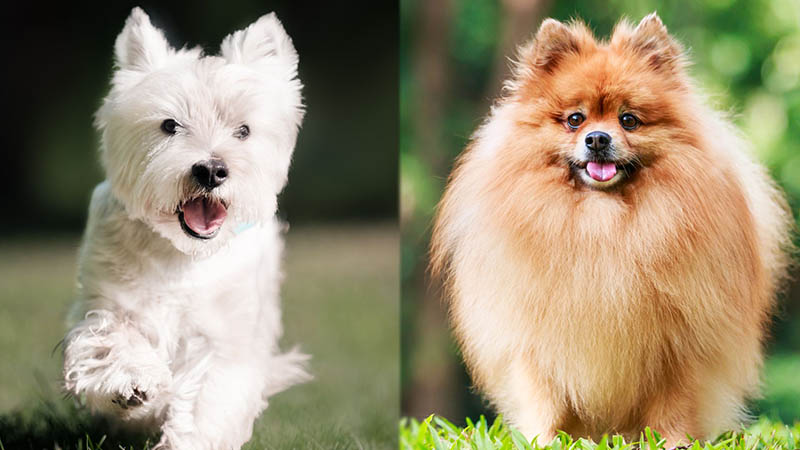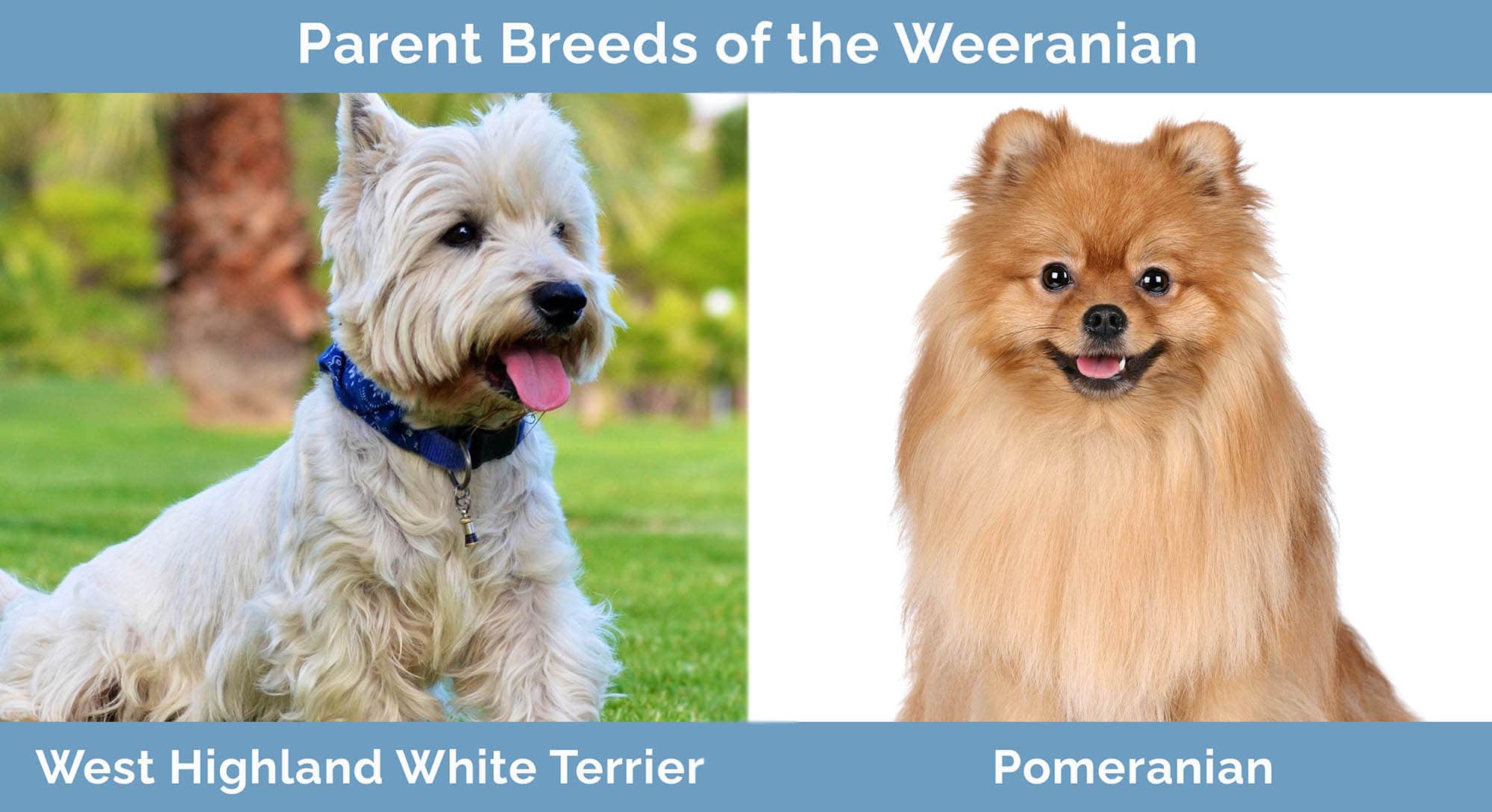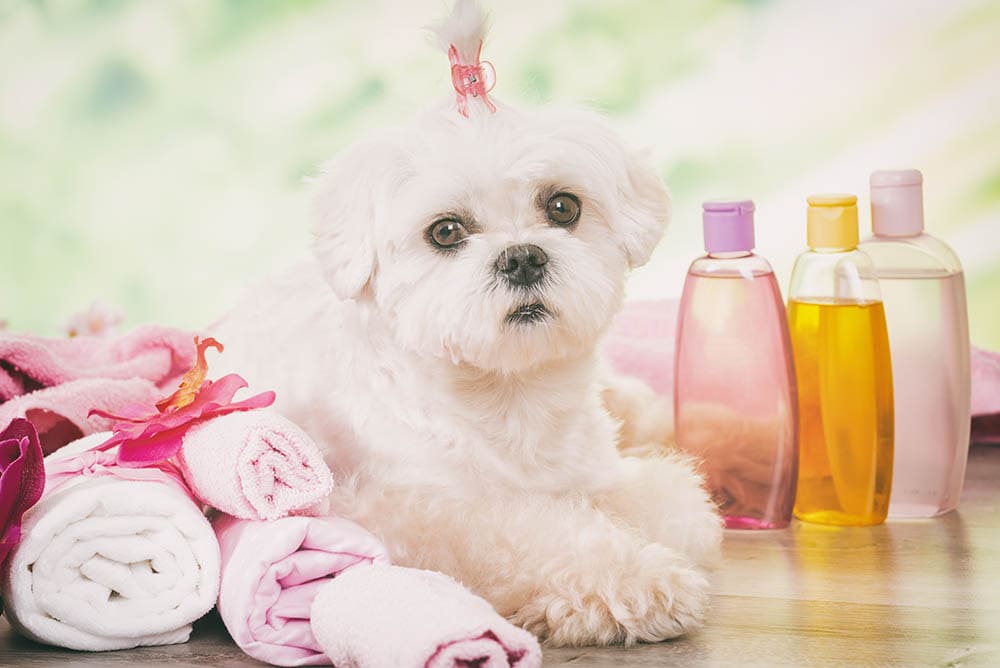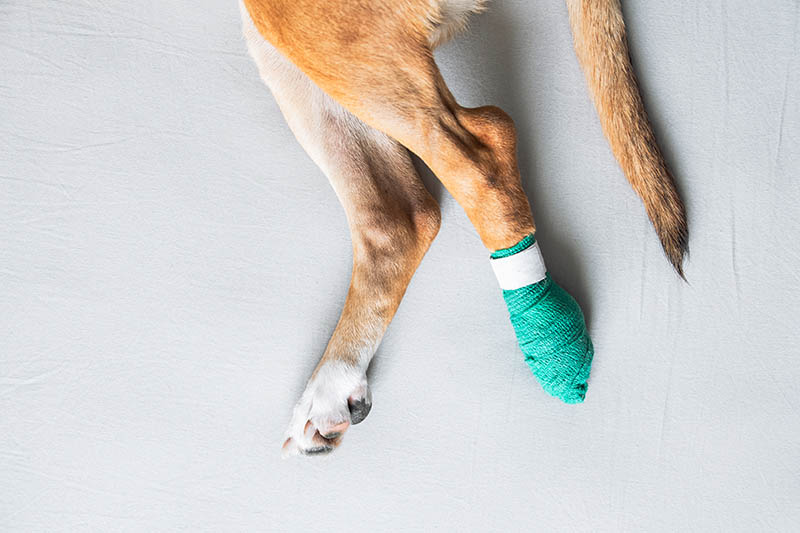Weeranian (Westie & Pomeranian Mix): Pictures, Care Guide, Temperament & Traits
By Kit Copson
Updated on

The Weeranian is a small mixed-breed dog, a cross between the West Highland White Terrier (Westie) and the Pomeranian. These dogs don’t typically grow any taller than 11 inches, weigh around 15 pounds, and have straight, medium to long coats and those infamous foxy facial features often seen in Spitz-type dogs.
Though this hybrid is not very common, we can learn more about the Westie-Pom mix by exploring the characteristics of the two parent breeds, so let’s dive in.
| Height: | Up to 11 inches |
| Weight: | Up to 20 pounds |
| Lifespan: | 12–16 years |
| Colors: | A very wide variety, including white, cream, red, brindle, gray, chocolate, orange, beaver, tri-colored & more |
| Suitable for: | All loving and respectful families, both large and small homes, experienced and first-time owners |
| Temperament: | Confident, merry, active, adaptable, affectionate |
As with many mixed breeds, the potential coat colors for the Weeranian are on a very broad spectrum. This is because though the Westie can only be white, Pomeranians have multiple color possibilities.
In addition to colors like cream, red, and chocolate, Weeranians can have a combination of colors, including black and tan and blue and tan, or a special coat pattern like Merle. Various markings including tri-color markings, white markings, mask, and parti-color could also be thrown into the mix.
Weeranian Puppies
These puppies aren’t the easiest to track down because they’re fairly rare, but if you’re looking to buy a Weeranian from a breeder, you’re likely looking at a fee ranging from around $250 to $1,000. This is based on the typical prices of Westie mixes and Pomeranian mixes.
We strongly recommend doing your research on any breeder you’re thinking of contacting to make sure their welfare standards are top-notch and that they have a solid reputation in the breeding and dog community.
Alternatively, plenty of shelters and adoption organizations are looking to get beautiful mixed breeds into new homes. If you don’t find a Weeranian via this avenue, one thing’s for sure—it’ll be hard not to find someone else to fall in love with, whether that’s a similar mix or a completely different type of dog that you just gel with from the get-go.

 Temperament & Intelligence of the Weeranian
Temperament & Intelligence of the Weeranian
Since the Westie and the Pomeranian are both such big characters, your Weeranian is likely to be no different! Well-socialized Westies are often cheerful, sturdy little souls that love to have fun, and Pomeranians are full of confidence inside those teeny-tiny bodies. Pomeranians are also known for being very alert and for thriving off of being the center of attention.
Since dogs’ personalities differ and aren’t based on breed alone, your Weeranian may have some of these traits, all of them, or have some special quirks of their own.
Are These Dogs Good for Families? 👪
If you’re committed to socializing and training your Weeranian from the moment you bring them home and everyone is gentle and respectful with them, then it’s easy to imagine this playful and confident mix assimilating perfectly into a family home.
If you have small children, you’ll need to be on hand to supervise the time they spend with your Weeranian to make sure everyone learns how to interact properly and safely with one another, but this applies to any kind of dog you bring home.
Do Weeranians Get Along with Other Pets?
Weeranians certainly can get along with other pets, but it’s best if they’re socialized alongside other pets from a young age. Remember that these dogs descend from Terriers—dogs that were bred to hunt a variety of animals including rats, badgers, and foxes—and so your Weeranian may have a strong instinct to give chase.
This could result in a few ruffled feathers at home, so be sure to lay down boundaries as early as possible so your Weeranian knows how to interact nicely with your other non-human companions. If you are adopting a Weeranian from a shelter, the staff will be able to help you decide if they would be a good fit for a home with other animals or if they’d be better off being the sole furbaby.
Things to Know When Owning a Weeranian
Food & Diet Requirements 🦴
Your Weeranian’s diet is one of the most important factors to consider, as it will be key in helping keep their digestive, skin, coat, and general health in check and maintaining a good weight.
We recommend exploring high-quality brands that are complete and balanced with all the essential nutrients dogs need, which are protein, carbohydrates, fats, vitamins, and minerals in varying amounts. You should also provide a bowl (or bowls) of clean water or a dog water fountain that your Weeranian has permanent access to.
The formula should be suitable for the life stage your Weeranian is at (puppy, adult, senior). If you’re unsure which formula would be best, you can ask your vet for suggestions. Furthermore, weighing your Weeranian’s food to ensure they’re getting the perfect portions recommended for their size helps keep their weight under control.
Exercise 🐕
Dogs’ exercise needs differ depending on their boundaries, their age, and their health. As a rule, Weeranians are lively pups and enjoy a few walks at a good pace every day and will certainly appreciate some free roaming time in a secure area (like a dog park) when possible.
Keep an eye on your Weeranian to see how quickly they tire out, and this will give you an estimate of how much exercise time they need per day. Some may need around an hour per day, but others may need more or less than this. If your Weeranian is acting destructively at home (e.g., chewing furniture), they may need a bit more exercise and mental stimulation.
Training 🎾
Small they may be, but Weeranians may very well inherit the boldness and assertiveness of Pomeranians and/or the independent Westie streak. This is great, but it means that they might run rings around you or simply do what they want rather than what they’re supposed to if you lack confidence during training sessions.
Weeranians need someone who is committed, patient, consistent, and kind but firm to train them. They respond very well to positive reinforcement, so your first step is to learn what your dog is motivated by (treats, toys, praise, ear scratches, etc.) and use that to your advantage.
For example, if your Weeranian simply salivates over treats, you can be sure they’ll be willing to work with you to get these as rewards for good behavior. Just be careful not to give too many treats—you don‘t want to inadvertently end up adding a few too many inches to your Weeranian’s waistline!
Grooming ✂️
Both West Highland Terriers and Pomeranians need to be brushed often—ideally every day, but if not, every few days—to prevent the coat from getting tangled up or matted.
During shedding seasons, your Weeranian might shed more hair than usual to make room for new hairs (Pomeranians “blow” their coats twice a year), so we recommend availing yourself of a de-shedding tool to keep things under control during these periods.
In addition to a coat grooming routine, it’s a good idea to brush the teeth, check your Weeranian’s ears for debris buildup or signs of infection regularly, and keep their nails trimmed to a reasonable length to prevent discomfort.
If you do the nail trimming at home, only trim the ends of the nails. Steer clear of the quick, which is the pink part that extends partway through the nail. Cutting into this area is very painful for dogs.
Health and Conditions 🏥
As dog parents, our dog getting sick is something we dread and don’t want to think about, but it’s always smart to be aware of the potential health issues that could affect them at some point. This knowledge will help you be vigilant for any changes in your dog and therefore seek treatment sooner. The below conditions can affect any dog but have been linked to one or both of the parent breeds.
- Mild allergies that receive treatment
- Gingivitis that is treated and managed
- Patellar luxation
- Legg-Calve-Perthes disease
- Heart conditions
- Eye conditions
Male vs Female
If you’re wondering whether a dog’s personality is determined by gender, it isn’t. We always recommend getting to know a dog, male or female, before you decide whether you’re destined for one another because that is the only way to truly know what the dog’s personality is like.
If you’re new to dog parenting, though, there are some things to be aware of if you don’t get your Weeranian spayed or neutered. Hormones can affect behavior in unspayed and unneutered dogs, both male and female.
Unspayed female small dogs typically go into heat every few months and being in heat can cause them to roam, urinate more, yowl, and become more clingy and more irritable. They also experience bleeding from the vulva. Unneutered males also have higher roaming tendencies, spray urine, and are more likely to fight with other male dogs. If this concerns you, speak to your vet about spaying or neutering.
 3 Little-Known Facts About the Weeranian
3 Little-Known Facts About the Weeranian
1. The Westie Used to Have a Different Name
In 1908, Westies were registered under the name “Roseneath Terrier”, but the name was changed to “West Highland White Terrier” the following year.
2. Pomeranians Have Long Been Adored by Royalty
The Weeranian’s other parent, the Pomeranian, has a very different backstory to the sturdy hunting dog that is the West Highland White Terrier. Pomeranians have long served as companion lapdogs, including for Queen Victoria, who was a huge fan of the breed. Marie Antoinette is another royal known to have owned Pomeranians.
3. Legend Has It That Westies Are White for a Reason
According to legend, Westies were bred to be white only to make them easier to see while out hunting and to prevent them from being accidentally shot. Legend has it that this idea was inspired by the accidental shooting of a reddish-colored dog.
Final Thoughts
Weeranians might be little dogs, but hold onto your hat—they’re far from shy and retiring and have enough confidence for a whole pack of big dogs! If you bring one of these lovely mixes home, you’re sure to have a faithful, charming, spirited, and good-humored companion that will never fail to put a smile on your face, even in the toughest of times.
Featured Image Credit: (L) Kalinina Maria, Shutterstock | (R) Jakkrit Orrasri, Shutterstock



 3 Little-Known Facts About the Weeranian
3 Little-Known Facts About the Weeranian










